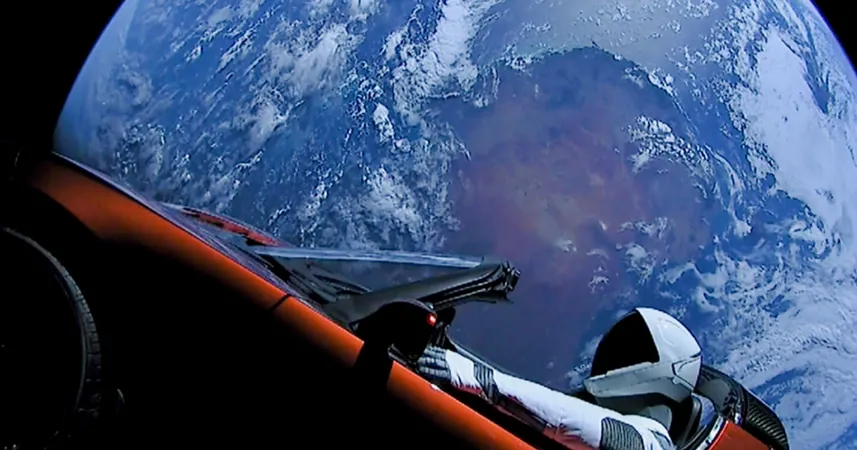
Are Brands Ready to Advertise in Space?
2025-04-15
Author: Yu
In a bold new era of space exploration, Jeff Bezos' all-female Blue Origin mission recently took flight, proving that the cosmos is no longer the exclusive playground of astronauts. Instead, it’s fast becoming the frontier for billionaires, brands, and audacious marketing strategies.
Is Space the Final Marketing Frontier?
The advertising sector, not satisfied with dominating Earth's landscapes, is now setting its eyes on the stars. Space advertising may sound like science fiction, but it’s a concept that's been on the table for decades.
Way back in 1996, Pepsi made headlines by paying the Russian government $5 million to display a can outside the Mir space station. More recently, in 2019, the brand considered a partnership with a Russian firm, StartRocket, to launch a space billboard—though public backlash quickly scrapped these plans.
Current Demand: A Mixed Picture
So, how much interest is there for ads in the great beyond? Dr. Robert Urban, a marketing consultant and head of the space marketing agency Paper Boat Media, suggests there's a true demand for sponsorships linked to space missions or satellites. “SpaceX and NASA are already collaborating with private firms,” he notes, but floating ads in orbit brings a host of ethical and logistical dilemmas people aren’t sure they want to embrace.
Astronomers have begun advocating for a global ban on space advertising, expressing concerns that flashing logos would blemish the pristine night sky—a shared resource. The American Astronomical Society warns that such billboards could disrupt astronomical research, which is already overwhelmed by satellites crowding up low Earth orbit.
The Bright Side: Near Space Advertising
Enter Sent Into Space, a pioneering marketing firm using high-altitude balloons to reach Near Space. Founded in 2011, the company has sent over 1,000 flights into the stratosphere while maintaining environmental responsibility. Their missions last mere hours before returning safely to Earth, minimizing any impact on the night sky. "We don’t leave space junk, period," asserts Mike Bull, Sent Into Space's sales executive.
They have sent everything from pizzas to chicken nuggets into space, occasionally collaborating with influencers like Logan Paul to launch promotional items. Despite being mostly novelty acts, these campaigns have been highly successful and are drawing interest from various industries.
Navigating Risks and Returns
For brands considering this celestial venture, measuring the return on investment can be tricky. Bull explains that social media engagement spikes with stunning visuals from space, rendering a significant ROI. "We don’t encounter negative publicity; we focus on leaving Earth and space as we found them," he states.
The costs of setting up orbital advertising could be steep—around $65 million for deploying 50 satellites. Yet, this could yield a net income of $111 million within a short timeframe if targeting major cities. Still, the 1966 Outer Space Treaty raises concerns about potentially hindering astronomical research.
Innovative Partnerships: The Future of Space Branding
Brands don't necessarily have to pollute the night sky to get involved with space. Companies like Estée Lauder have made headlines by sponsoring missions, such as paying NASA to transport skincare products into orbit for a photoshoot. More collaborations with space agencies promise to pave the way for more innovative branding strategies without disrupting the celestial canvas.
As humanity journeys further into the cosmos, the intersection of advertising and space exploration presents fascinating possibilities, but the balance between commercial interests and environmental preservation remains a critical challenge.



 Brasil (PT)
Brasil (PT)
 Canada (EN)
Canada (EN)
 Chile (ES)
Chile (ES)
 Česko (CS)
Česko (CS)
 대한민국 (KO)
대한민국 (KO)
 España (ES)
España (ES)
 France (FR)
France (FR)
 Hong Kong (EN)
Hong Kong (EN)
 Italia (IT)
Italia (IT)
 日本 (JA)
日本 (JA)
 Magyarország (HU)
Magyarország (HU)
 Norge (NO)
Norge (NO)
 Polska (PL)
Polska (PL)
 Schweiz (DE)
Schweiz (DE)
 Singapore (EN)
Singapore (EN)
 Sverige (SV)
Sverige (SV)
 Suomi (FI)
Suomi (FI)
 Türkiye (TR)
Türkiye (TR)
 الإمارات العربية المتحدة (AR)
الإمارات العربية المتحدة (AR)